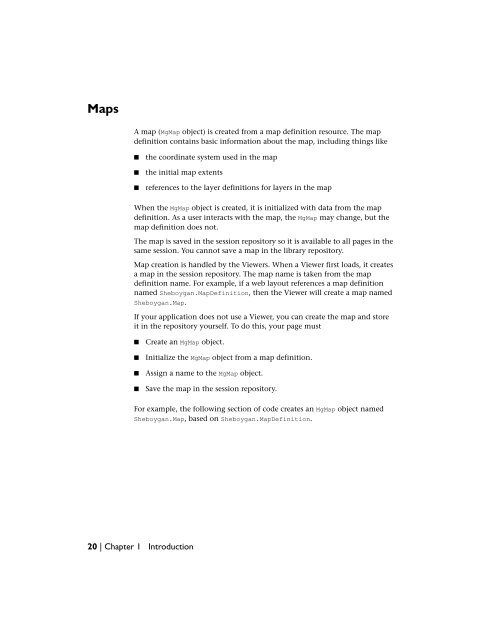Developer's Guide - MapGuide Open Source - OSGeo
Developer's Guide - MapGuide Open Source - OSGeo
Developer's Guide - MapGuide Open Source - OSGeo
You also want an ePaper? Increase the reach of your titles
YUMPU automatically turns print PDFs into web optimized ePapers that Google loves.
Maps<br />
A map (MgMap object) is created from a map definition resource. The map<br />
definition contains basic information about the map, including things like<br />
■ the coordinate system used in the map<br />
■ the initial map extents<br />
■ references to the layer definitions for layers in the map<br />
When the MgMap object is created, it is initialized with data from the map<br />
definition. As a user interacts with the map, the MgMap may change, but the<br />
map definition does not.<br />
The map is saved in the session repository so it is available to all pages in the<br />
same session. You cannot save a map in the library repository.<br />
Map creation is handled by the Viewers. When a Viewer first loads, it creates<br />
a map in the session repository. The map name is taken from the map<br />
definition name. For example, if a web layout references a map definition<br />
named Sheboygan.MapDefinition, then the Viewer will create a map named<br />
Sheboygan.Map.<br />
If your application does not use a Viewer, you can create the map and store<br />
it in the repository yourself. To do this, your page must<br />
■ Create an MgMap object.<br />
■ Initialize the MgMap object from a map definition.<br />
■ Assign a name to the MgMap object.<br />
■ Save the map in the session repository.<br />
For example, the following section of code creates an MgMap object named<br />
Sheboygan.Map, based on Sheboygan.MapDefinition.<br />
20 | Chapter 1 Introduction


